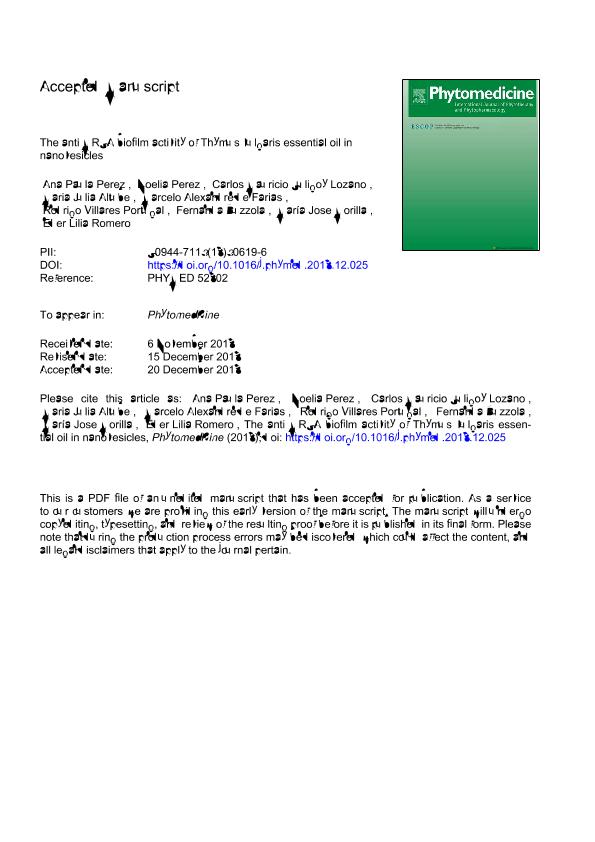Mostrar el registro sencillo del ítem
dc.contributor.author
Perez, Ana Paula
dc.contributor.author
Perez, Noelia Soledad

dc.contributor.author
Suligoy Lozano, Carlos Mauricio

dc.contributor.author
Altube, María Julia

dc.contributor.author
de Farias, Marcelo Alexandre
dc.contributor.author
Portugal, Rodrigo Villares
dc.contributor.author
Buzzola, Fernanda Roxana

dc.contributor.author
Morilla, María José

dc.contributor.author
Romero, Eder Lilia

dc.date.available
2020-12-21T13:15:21Z
dc.date.issued
2019-04
dc.identifier.citation
Perez, Ana Paula; Perez, Noelia Soledad; Suligoy Lozano, Carlos Mauricio; Altube, María Julia; de Farias, Marcelo Alexandre; et al.; The anti MRSA biofilm activity of Thymus vulgaris essential oil in nanovesicles; Elsevier Gmbh; Phytomedicine; 57; 4-2019; 339-351
dc.identifier.issn
0944-7113
dc.identifier.uri
http://hdl.handle.net/11336/120904
dc.description.abstract
Background: Thymus vulgaris essential oil (T) could be an alternative to classical antibiotics against bacterial biofilms, which show increased tolerance to antibiotics and host defence systems and contribute to the persistence of chronic bacterial infections. Hypothesis: A nanovesicular formulation of T may chemically protect the structure and relative composition of its multiple components, potentially improving its antibacterial and antibiofilm activity. Study design: We prepared and structurally characterized T in two types of nanovesicles: nanoliposomes (L80-T) made of Soybean phosphatidylcholine (SPC) and Polysorbate 80 (P80) [SPC:P80:T 1:0.75:0.3 w:w], and nanoarchaeosomes (A80-T) made of SPC, P80 and total polar archaeolipids (TPA) extracted from archaebacteria Halorubrum tebenquichense [SPC:TPA:P80:T 0.5:0.50.75:0.7 w:w]. We determined the macrophage cytotoxicity and the antibacterial activity against Staphylococcus aureus ATCC 25,923 and four MRSA clinical strains. Results: L80-T (Z potential −4.1 ± 0.6 mV, ∼ 115 nm, ∼ 22 mg/ml T) and A80-T (Z potential −6.6 ± 1.5 mV, ∼ 130 nm, ∼ 42 mg/ml T) were colloidally and chemically stable, maintaining size, PDI, Z potential and T concentration for at least 90 days. While MIC 90 of L80-T was > 4 mg/ml T, MIC 90 of A80-T was 2 mg/ml T for all S. aureus strains. The antibiofilm formation activity was maximal for A80-T, while L80-T did not inhibit biofilm formation compared to untreated control. A80-T significantly decreased the biomass of preformed biofilms of S. aureus ATCC 25,923 strain and of 3 of the 4 clinical MRSA isolates at 4 mg/ml T. It was found that the viability of J774A.1 macrophages was decreased significantly upon 24 h incubation with A80-T, L80-T and T emulsion at 0.4 mg/ml T. These results show that from 0.4 mg/ml T, a value lower than MIC 90 and the one displaying antibiofilm activity, with independence of its formulation, T significantly decreased the macrophages viability. Conclusion: Overall, because of its lower MIC 90 against planktonic bacteria, higher antibiofilm formation capacity and stability during storage, A80-T resulted better antibacterial agent than T emulsion and L80-T. These results open new avenues to explode the A80-T antimicrobial intracellular activity.
dc.format
application/pdf
dc.language.iso
eng
dc.publisher
Elsevier Gmbh

dc.rights
info:eu-repo/semantics/openAccess
dc.rights.uri
https://creativecommons.org/licenses/by-nc-nd/2.5/ar/
dc.subject
ANTIBIOFILM ACTIVITY
dc.subject
NANOVESICLES
dc.subject
THYMUS VULGARIS ESSENTIAL OIL
dc.subject.classification
Biología Celular, Microbiología

dc.subject.classification
Ciencias Biológicas

dc.subject.classification
CIENCIAS NATURALES Y EXACTAS

dc.title
The anti MRSA biofilm activity of Thymus vulgaris essential oil in nanovesicles
dc.type
info:eu-repo/semantics/article
dc.type
info:ar-repo/semantics/artículo
dc.type
info:eu-repo/semantics/publishedVersion
dc.date.updated
2020-12-18T19:33:05Z
dc.journal.volume
57
dc.journal.pagination
339-351
dc.journal.pais
Alemania

dc.description.fil
Fil: Perez, Ana Paula. Universidad Nacional de San Martín. Escuela de Ciencia y Tecnología; Argentina
dc.description.fil
Fil: Perez, Noelia Soledad. Consejo Nacional de Investigaciones Científicas y Técnicas; Argentina. Universidad Nacional de San Martín. Escuela de Ciencia y Tecnología; Argentina
dc.description.fil
Fil: Suligoy Lozano, Carlos Mauricio. Consejo Nacional de Investigaciones Científicas y Técnicas. Oficina de Coordinación Administrativa Houssay. Instituto de Investigaciones en Microbiología y Parasitología Médica. Universidad de Buenos Aires. Facultad de Medicina. Instituto de Investigaciones en Microbiología y Parasitología Médica; Argentina
dc.description.fil
Fil: Altube, María Julia. Universidad Nacional de San Martín. Escuela de Ciencia y Tecnología; Argentina. Consejo Nacional de Investigaciones Científicas y Técnicas; Argentina
dc.description.fil
Fil: de Farias, Marcelo Alexandre. No especifíca;
dc.description.fil
Fil: Portugal, Rodrigo Villares. No especifíca;
dc.description.fil
Fil: Buzzola, Fernanda Roxana. Consejo Nacional de Investigaciones Científicas y Técnicas; Argentina. Consejo Nacional de Investigaciones Científicas y Técnicas. Oficina de Coordinación Administrativa Houssay. Instituto de Investigaciones en Microbiología y Parasitología Médica. Universidad de Buenos Aires. Facultad de Medicina. Instituto de Investigaciones en Microbiología y Parasitología Médica; Argentina
dc.description.fil
Fil: Morilla, María José. Consejo Nacional de Investigaciones Científicas y Técnicas; Argentina. Universidad Nacional de San Martín. Escuela de Ciencia y Tecnología; Argentina
dc.description.fil
Fil: Romero, Eder Lilia. Universidad Nacional de San Martín. Escuela de Ciencia y Tecnología; Argentina. Consejo Nacional de Investigaciones Científicas y Técnicas; Argentina
dc.journal.title
Phytomedicine

dc.relation.alternativeid
info:eu-repo/semantics/altIdentifier/doi/http://dx.doi.org/10.1016/j.phymed.2018.12.025
dc.relation.alternativeid
info:eu-repo/semantics/altIdentifier/url/https://www.sciencedirect.com/science/article/abs/pii/S0944711318306196
Archivos asociados
